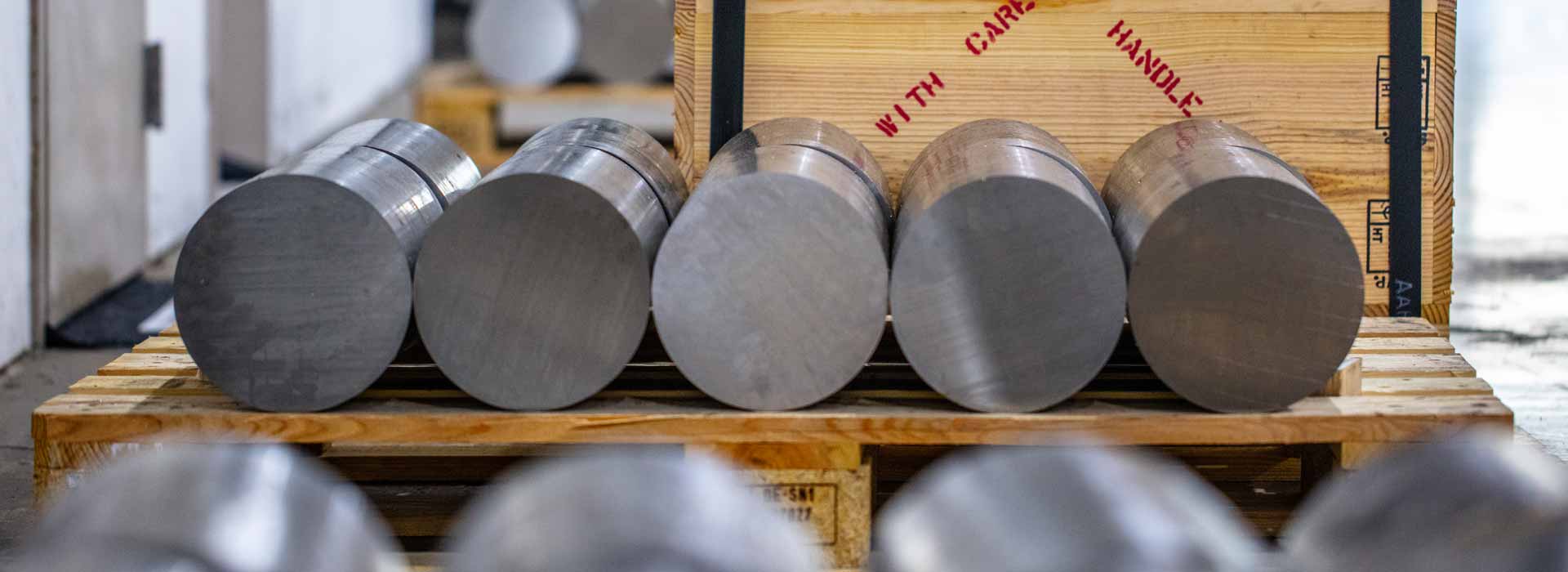Abbreviation for American Society For Testing Material. An organization for issuing standard specifications on materials, including metals and alloys.
Hardened, tempered polished and blued or yellow flat steel with dressed edges. Carbon content about 1.00. Material has to possess good flatness, uniform hardness and high elasticity.
Brittleness resulting from pickling steel in acid; hydrogen, formed by the interaction between iron and acid, is partially absorbed by the metal, causing acid brittleness.
A process of making steel, either Bessemer, open-hearth or electric, in which the furnace is lined with a siliceous refractory and for which low phosphorous pig iron is required as this element is not removed.
The term has no reference to the acidity of the steel. (See acid process.)
The term as applied to soft, or low carbon steels, relates to a wide variety of commercially important, slow, gradual changes that take place in properties of steels after the final treatment. These changes, which bring about a condition of increased hardness, elastic limit, and tensile strength with a consequent loss in ductility, occur during the period in which the steel is at normal temperatures.
Spontaneous change in the physical properties of some metals, which occurs on standing, at atmospheric temperatures after final cold working or after a final heat treatment. Frequently synonymous with the term "Age-Hardening."
Cooling of the heated metal, intermediate in rapidity between slow furnace cooling and quenching, in which the metal is permitted to stand in the open air.
Alloy steel which may be hardened by cooling in air from a temperature above the transformation range. Such steels attain their martenstic structure without going through the quenching process. Additions of chromium, nickel, molybdenum and manganese are effective toward this end.
Steels of the American Iron and Steel Institute. Common and alloy steels have been numbered in a system essentially the same as the SAE. The AISI system is more elaborate than the SAE in that all numbers are preceded by letters: "A" represents basic open-hearth alloy steel, "B" acid Bessemer carbon steel, "C" basic open-hearth carbon steel, "CB" either acid Bessemer or basic open-hearth carbon steel, "E" electric furnace alloy steel.
The common name for a type of clad wrought aluminum products, such as sheet and wire, with coatings of high-purity aluminum or an aluminum alloy different from the core alloy in composition. The coatings are anodic to the core so they protect exposed areas on the core electrolytically during exposure to corrosive environments,
(Met.) Metal prepared by adding other metals or non-metals to a basic metal to secure desirable properties.
Steel containing substantial quantities of elements other than carbon and the commonly-accepted limited amounts of manganese, sulfur, silicon, and phosphorous. Addition of such alloying elements is usually for the purpose of increased hardness, strength or chemical resistance. The metals most commonly used for forming alloy steels are: nickel, chromium, silicon, manganese, tungsten, molybdenum and vanadium. "Low Alloy" steels are usually considered to be those containing a total of less than 5% of such added constituents.
A copper-zinc alloy containing up to 38% of zinc. Used mainly for cold working.
A copper-tin alloy consisting of the alpha solid solution of tin in copper. Commercial forms contain 4 or 5% of tin. This alloy is used in coinage, springs, turbine, blades, etc.
The polymorphic form of iron, stable below 1670°F. has a body centered cubic lattice, and is magnetic up to 1410°F.
(Chemical symbol Al] Element No. 13 of the periodic system; Atomic weight 26.97; silvery white metal of valence 3: melting point 1220°F.; boiling point approximately 4118°F.; ductile and malleable; stable against normal atmospheric corrosion, but attacked by both acids and alkalis. Aluminum is used extensively in articles requiring lightness, corrosion resistance, electrical conductivity, etc. Its principal functions as an alloy in steel making: [1] Deoxidizes efficiently (See Aluminum Killed) (2) Restricts grain growth (by forming dispersed oxides or nitrides) (3) Alloying element in nitriding steel (see).
A steel where aluminum has been used as a deoxidizing agent. (See Killed Steel.]
A heating and cooling operation implying usually a relatively slow cooling. Annealing is a comprehensive term. The process of such a heat treatment may be: to remove stresses; to induce softness: to alter ductility; toughness; electrical magnetic, or other physical properties; to refine the crystalline structure; to remove gases: to produce a definite micro-structure. In annealing, the temperature of the operation and the rate of cooling depend upon the material being heat treated and the purpose of the treatment.
(Aluminum Anodic Oxide Coating) - A process of coating aluminum by anodic treatment resulting in a thin film of aluminum oxide of extreme hardness. A wide variety of dye colored coatings are possible by impregnation in process.
An aging treatment above room temperature. See precipitation heat treatment and compare with natural aging.
A trade name for a patented heat treating process that consists in quenching a ferrous alloy from a temperature above the transformation ranges, in a medium having a rate of beat abstraction sufficiently high to prevent the formation of high-temperature transformation products and in maintaining the alloy, until transformation is complete, at a temperature below that of pearlite formation and above that of martensite formation.
Phase in certain steels, characterized as a solid solution, usually off carbon or iron carbide, in the gamma form of iron. Such steels are known as "austenitic," Austenite is stable only above 1333 ?F. in a plain carbon steel, but the presence of certain alloying elements, such as nickel and manganese, stabilizes the austenitic form, even at normal temperatures.
Steel which, because of the presence of alloying elements, such as manganese, nickel, chromium, etc., shows stability of Austenite at normal temperatures.
